Like most builders, I like to tinker with our plane. We built my RV-4 over a period of five years seven months, and it first flew in 1991. It now has over 2500 hours and has taken my wife, who is also a pilot, and me over 500,000 miles. It’s difficult to express what a joy it has been to be able to fly a machine of our own fabrication, to go anywhere you want to go, and to meet so many different and incredibly amazing people that, over the years, become your friends.
Many builders continue to build other planes and others modify their existing ones. Well, I’ve continued to modify mine over the years. I’m a dentist by education but an aviation enthusiast by passion. I loved listening to and discussing aviation and aeronautical ideas with my friends that were truly knowledgeable about these things. Over the years I’ve been blessed by the generosity of those people sharing their ideas with me. I enjoyed taking those ideas, reading about how to do them, and then trying to apply them to my plane.
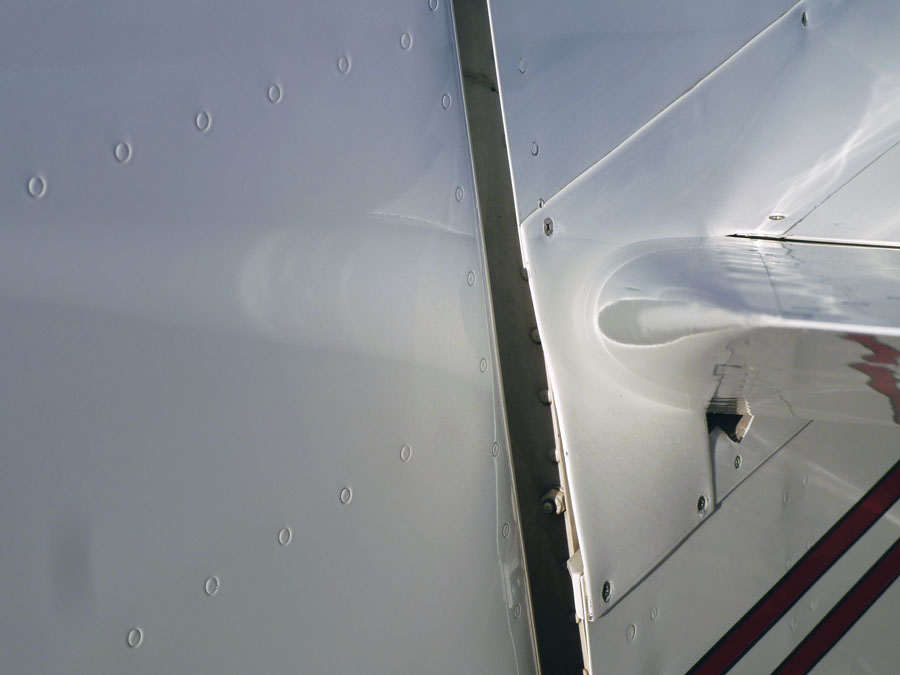
Inboard elevator fairings, made from one layer of boat deck glass and one layer of Rutan glass, are very lightweight.
The early history of our plane is documented in the CAFE Foundation Aircraft Performance Report, “RV-4 New CAFE Triaviathon Champion,” by Brien Seeley and the CAFE Board, which appeared in the January 1998 issue of Sport Aviation.
When our plane was first completed, its max speed was about 217 mph. We heard about the Sun 100 race at the Sun ‘n Fun fly-in in Lakeland, Florida, so in 1993 we headed there to race with the simplest modifications and racing techniques I could adapt to our plane. Our plane went 230 mph that year, and I was hooked. The speeds I claim our plane has gone over the years are from race results when someone else was holding the stopwatch. I know all of us pilots would never overestimate our planes’ performance. However, it really is hard to get good data. At the last Sun 100 race I competed in, in 2000, our plane went 261 mph, and for those that don’t know, those were standing-start races. That is a documented 44 mph increase.
Formulas for Success
There are a few simple formulas that when applied to the same plane year after year can reveal what change produced the increase in mph performance.
thrust hp = flat plate area (square feet) x speed cubed (mph) / 146225
thrust hp = hp output / prop efficiency
hp = fuel flow x 5.9 lbs/gal / bsfc
Brake specific fuel consumption (bsfc) for a stock O-360 is about .50 and for an O-360 with 10.5:1 compression, flowed with everything, is about .44. These may be rule-of-thumb figures, but when used on the same airplane each time something is changed, you can draw pretty good conclusions. For instance, if you didn’t work on your engine or change the rpm it’s running and didn’t do any work on the propeller, then any increase is due to drag changes. Likewise, if you didn’t change the airframe or propeller and you’re burning more fuel at the same rpm, then any increase is from hp gain.
A couple more useful formulas I have used are:
hp = torque x rpm / 5252
hp required / object = (dynamic pressure) x (sq ft of the object) x (drag coefficient of object) x (TAS in FT/sec) / (550 ft lb sec/ hp x prop efficiency)
hp required/object is the hp required to drag any protruding object on your plane through the air: i.e., exposed hinges or an antenna
Dynamic pressure (Q) is in pounds/square feet where:
Q = 1/2 PV squared
P = air density 0.00238 (sea level standard day)
V = TAS (in feet/second) (1 mph = 1.467 feet/second)
Drag coefficient is a number that represents the force of the wind as compared to what you would expect. For example, a 1-square-foot plate moving perpendicular to the path of the air has a greater drag coefficient than 1, actually about 1.3, due to increases from edge and wake turbulence. A good simple source to see shape effects on drag coefficients is to Google “Drag Coefficient Wikipedia.”
The use of the hp/object formula proved it took about 2.4 hp to pull the unfaired aileron hinge bracket through the air at top speed and only about 0.1 hp when they had canoe fairings placed. So by going back to the previous formulas, an increase of 2.3 hp would amount to about 1+ mph in max speed. It’s just good science though you probably can’t demonstrate that small of a performance increase.
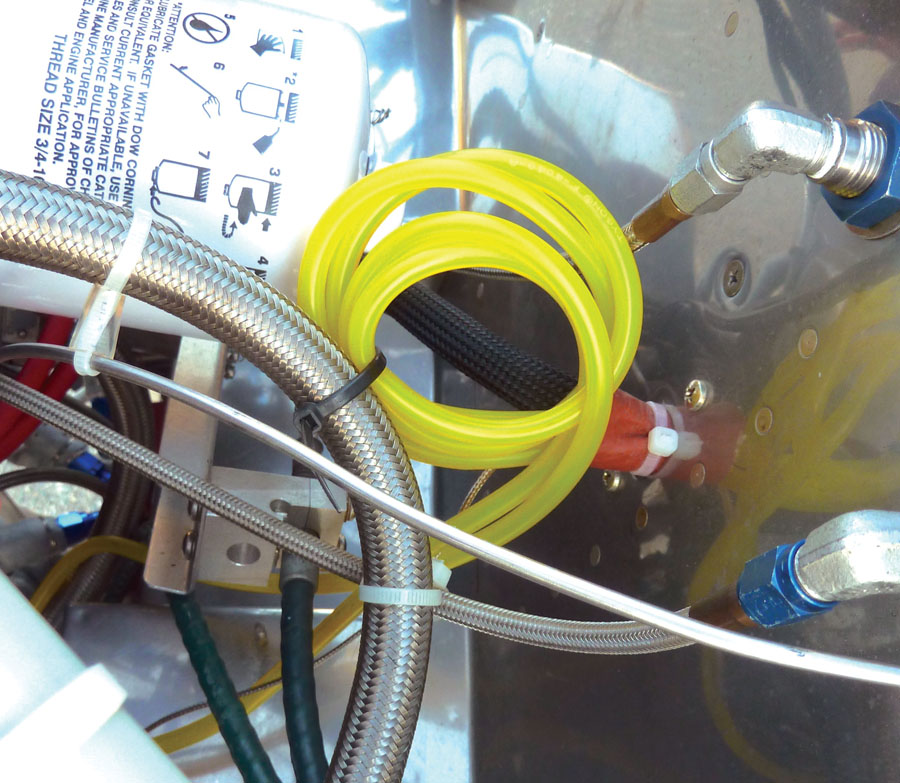
Permanent firewall pass-through for testing equipment is currently used for pressure and temperature testing.
The thing that may interest some people is the efficiency increase that came along with the modifications. By using the formulas above, 24.5 mph came from drag reduction, which for my plane was about a 27% decrease in total airframe drag. Another way to look at it is that in 2500 hours, I may have saved $16,000 in fuel due to burning about 22% less fuel than the day I first flew my plane. In the October 1997 issue of The RVator from Van’s Aircraft, Dick VanGrunsven calculated that, as he put it, the “Anders Airframe” was responsible for 18.2 of the mph increase. By 2000 the airframe increased an additional 6.3 mph by further drag reduction alone.
In 2006 I was asked to give a talk at the Golden West Fly-in in California about my RV-4 performance increases. I prepared some notes for the talk, which were later reproduced by the Sacramento RVators, and can be found at www.sacrvators.com or by searching “Dave Anders aircraft efficiency.” They may not be easy to interpret because some are in my kind of shorthand, but the ideas still apply.
There is one thing I would like to add: If anyone uses any of the modifications I did, but starts at a different total airframe drag than I had at the time of my modification and/or does the modifications in a different order, the performance increase may not be the same due to the drag ratio reduction being different.
Mods for Speed and Efficiency
Over the life of our plane we have made over 30 modifications, some major and some not. The propeller was twisted and then re-twisted according to Hartzell’s recommendation by American propeller, and they have completely inspected and reassembled it many times without ever finding a defect. The engine has been continually modified by Ly-Con and at one time produced over 235 hp on the dyno. However, the greatest performance increases came from drag reduction, which required more work then expense. The greatest economy increases came from drag reductions and the addition of the Light Speed Plasma ignitions.
Most of the builders today are adding some of these concepts into their planes as they are building. We all have always built on the experiences of past builders that have been so gracious with their help.
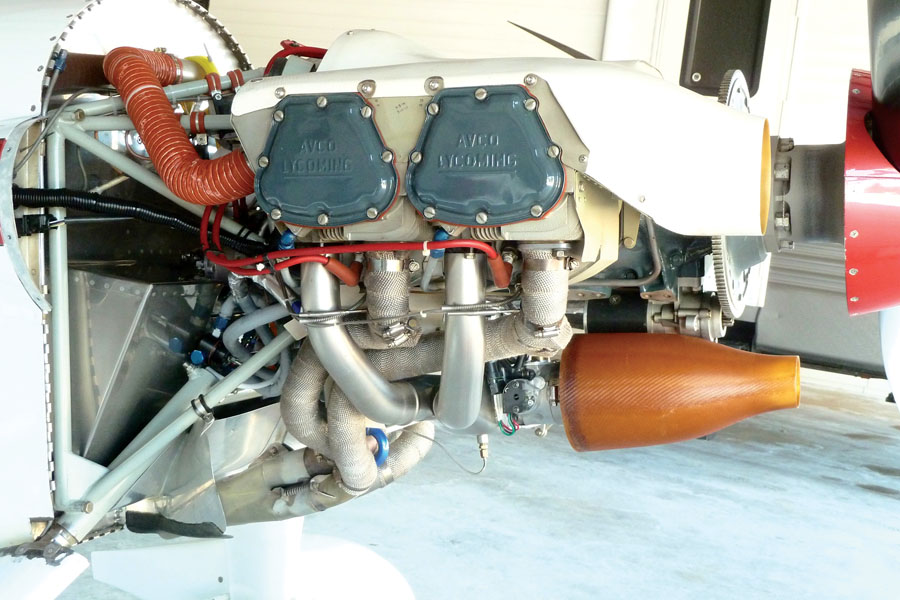
A lot going on here: temperature control with infrared oil sump shield and high-temperature exhaust wrap, convergence zone for cooling exit, 8-degree diffuser ram air box with elliptical velocity stack inside.
I have been concentrating on efficiency for years as well as speed. In 2007 our RV-4 competed in the CAFE Foundation PAV Challenge (personal air vehicle) in Santa Rosa, California. The challenge had many requirements, one of which was fuel economy at gross-weight takeoff for a 400-mile course with 20,000 feet of elevation changes, climbs, and descents throughout the course. We were only beaten by a carbon-fiber Pipistrel Virus long-winged motorglider; it had better fuel economy by 2.4 mpg, but we were over 30 mph faster. Our speed was limited to the maximum fuel efficiency (mph x mpg). Not bad for a fat-winged RV-4.
In other requirements of the challenge, we flew 2 mph slower IAS then the Pipistrel in slow flight, had cabin noise 2 dBA lower than any other competitor, outclimbed the Pipistrel by over 1100 fpm, and took off over a 50-foot object in 1360 feet (in a crosswind) with maximum takeoff noise outside the plane at 64.5 dBA, which is an almost-no-power takeoff.
All of these competitions only serve to make an individual try to get more out of what they have to work with and verified my efforts. I love the competitions; they make you experiment. I have continued making further modifications to my plane, but about five years ago, I decreased my engine’s horsepower. In the past I have run compressions all the way up to 12.2:1, and now I have about 10:1, so the data from my plane today is with that in mind.
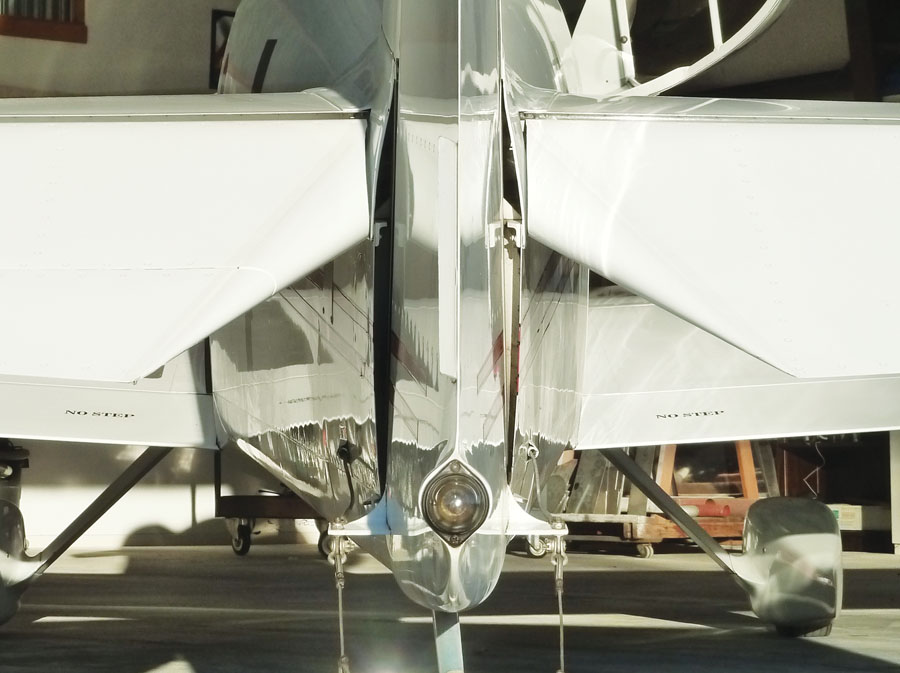
Empennage control surfaces with .050-inch bonded and riveted trailing edges. All surfaces are .020 skins, and the rudder has a rib every other stiffener for stronger, stiffer surfaces.
Fuel Injection and Electronic Ignition
In the December 2015 issue of KITPLANES, I read the article, “Fuel injection—Putting Pressure Into Fuel Delivery” by Tom Wilson, and I’ve flown with and competed against Klaus Savier of Light Speed Engineering for years. Back then he had his electronic ignition, and then he put in electronic fuel injection. He was very fast, and his economy was unbelievable. I knew that his unrelenting goal for low drag and these two electronic devices were amazing, all in their own right. I began running Klaus’ Plasma ignitions and was very impressed at the increase in performance and economy. I did what I could do with drag, and I think I have found most of the easy things aerodynamically. However, I still have an RV-4, and it will never compete with ultra-low-drag airframes or ones with mega-horsepower.
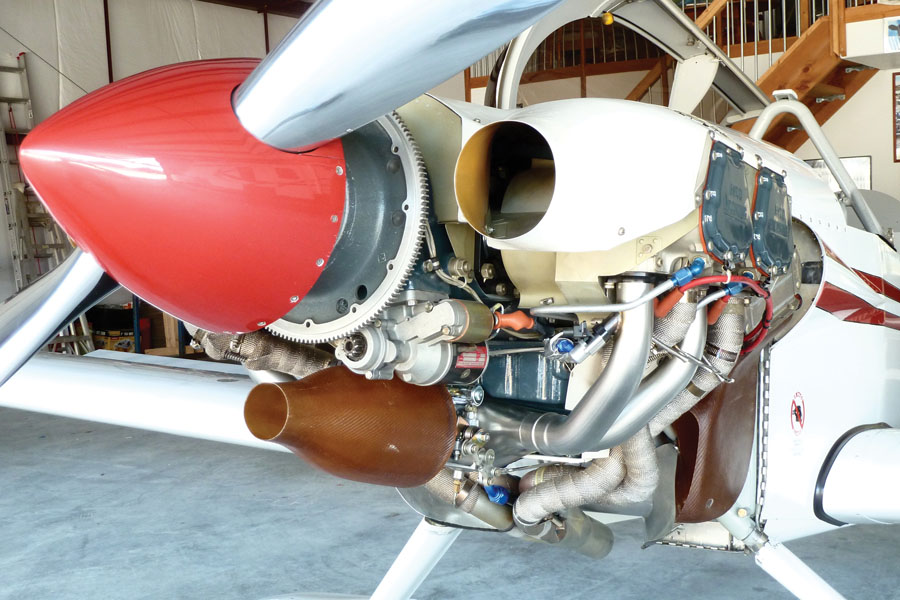
Left side axisymmetric inlet with 8-degree diffuser to engine plenum and oil cooler afterbody fairing on the lower right.
I was running a forward-facing modified Bendix fuel injection system with matched fuel injectors, but I could never get balanced EGTs at maximum power and then again at low power maximum economy, so I opted for maximum power. The only reasonable major change that I could still do was put on electronic fuel injection (EFI). I didn’t want to remove Klaus’ electronic ignition that I had run for so long with total success. I have to add that my electronic ignition is also in-the-cockpit variable +/- about 8 degrees, which is something else I didn’t want to give up. However, it’s probably a feature that could get you into trouble if you ever take off at low-altitude airports with it all the way advanced. That’s something I try not to forget.
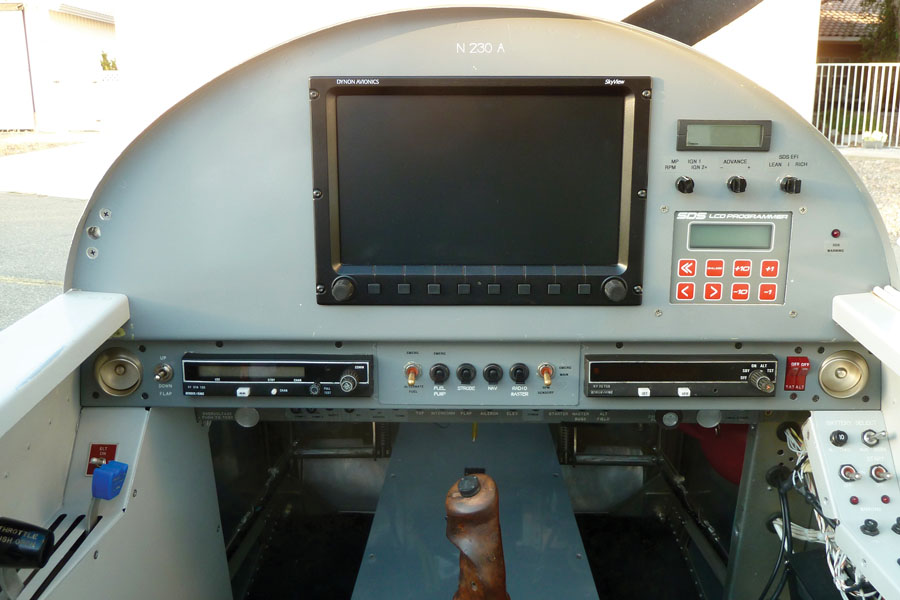
Simple, lightweight VFR panel with Dynon SkyView, trim knobs, and programing panel for the Light Speed ignitions and SDS EFI.
As I researched available EFI systems, I contacted Ross Farnham in Canada to learn about his Simple Digital System (SDS). He said he would work with me and told me what I would need to run his system as per the required electrical pulse input to power the ECU for rpm. All it needed was a 2-pulse/rev 5-100v source with adequate pulse width, which Klaus’ Light Speed Plasma III ignitions provide. Ross and Klaus were there and helpful at every step. I wanted to talk with someone that had been around for a long time with lots of experience. Ross’ Racetech business had been in operation since 1987 and had hundreds of thousands of hours on their product. It turned out that he also flies behind it in his own planes, and Mike Dacey used it in his quite complex Questair Venture at the Reno Air Races when he took 1st place in the Sport class. So, I also called Mike and asked him about the SDS, and he said it made fuel management in his Venture easy and gave it great reviews.
It took about three months for me to unbuild my RV-4 and then install the SDS ECU. Ross said he would put in the map values so the engine would start on the first try. Well, on the first try after about 1 to 2 blades, it fired up and even idled. The SDS has some really neat features that are provided.
- The fuel pump runs for 2.8 seconds when the ECU is first powered on to pressurize and prime.
- Further priming is available by pumping the throttle without the engine turning for cold climates.
- There’s a fuel pump cutoff with loss of rpm.
- An electronic accelerator pump allows you to advance the throttle rapidly at idle without engine hesitation or dying.
- A similar accelerator pump allows rapid throttle change in flight.
- A lambda sensor, which is an air fuel ratio probe, chemically determines the air-fuel ratio (AFR) in the exhaust tube and converts it to a voltage that is displayed as a number on the SDS programmer. It’s easy to set the AFRs by changing the values in the ECU mapping.
- Mapping allows you to set any AFR you like, so you can always have maximum power when you advance the throttle. This gives you maximum power, say 12.4 AFR or whatever you want, on takeoff instead of maximum rich. This is a great feature at places like Leadville, Colorado. You will also notice a difference in your climb performance because it simply stays at whatever AFR you have set during the entire climb. An AFR of 9 is very rich, and 19 is very lean. Maximum power is typically around 12.4, and stoichiometric (max EGT) is around 14.7 to 15.1 depending on the fuel type (i.e., auto fuel or avgas).
- A mixture trim knob allows you to change the fuel flow at any time by 50% simply by moving the knob to rich or lean. You are not locked out, a feature I like.
- Individual cylinder trim lets you match all cylinders at the same time for maximum power or maximum economy when you want to.
- Data logging of all maps is downloadable.
SDS installation is pretty simple. The bolt-on injectors go in the 1/8-inch pipe fitting primer locations or replace the 1/8-inch pipe fitting injectors. There are many more features, including staged injection and items that I do not use.
So far, the unit has worked as claimed. All you do is adjust the values in the mapping to provide the AFR you want at every rpm. The thing I notice is that the engine idles smoother than it ever has before. It will idle down to about 550 rpm, but 620 rpm is really smooth. It normally starts on about 1 to 1-1/2 blades, and there is no hot start problem at all. When I tested it, I wanted it to fail or act up on the runway, so I tied it to my truck and ran the engine at power until it was heat soaked. It was showing 370F on one head and 360F on the others, which was a temperature I had never seen before. The oil temp was 232 (below redline). I shut it down, waited 4 or 5 minutes, and restarted it. I figured if there was any chance of vapor locking that should do it. It restarted in about 1-1/2 blades and idled at 620 rpm without hesitation.
I think there may be even more benefits to discover than I’ve mentioned already. I can lean the engine to 19 AFR, and it still runs but with just no power. Our plane never ran perfect at high altitudes with low manifold pressures. It would just start having a random miss when I ran it down below a fuel flow of about 5.4 gph, which I always attributed to the loss injector pressures of the Bendix system at high altitudes. Well, the SDS runs smooth at 4 gph or lower in our plane. It also idles at about 1/2 gph now, which it wouldn’t do before. To date I have tested wide open throttle (WOT) maximum continuous power at low altitudes, WOT climbs from our 600-foot MSL airport to 17,500 feet, and high- and low-power cruises at intermediate altitudes. I am beginning to gather data at high altitude maximum economy, all of which I am very pleased with so far. The high-pressure atomization of the EFI is amazing. It’s a wonderful addition to an already great plane, and I fully expect it to add to our plane’s efficiency even more.
I would like to thank the friends and contributors that have provided help and guidance in my effort to experiment. Without their help it would not have been possible. In alphabetical order: Diane Anders, my right hand; Ross Farnham, owner, SDS EFI; Peter Garrison, journalist, author, airplane designer, software engineer; Dave Howe, engineer; Ken Krueger, owner, Sky Designs Engineering, aero engineer; David Lednicer, aero engineer, computational fluid dynamics; John Lynch, owner, JL Design, structural design and computer modeling; Rick McWilliams, aero engineer; Klaus Savier, owner, Light Speed Engineering; Ken Tunnell, owner, Ly-Con Aircraft Engines; Dick VanGrunsven, founder and CEO, Van’s Aircraft, engineer.

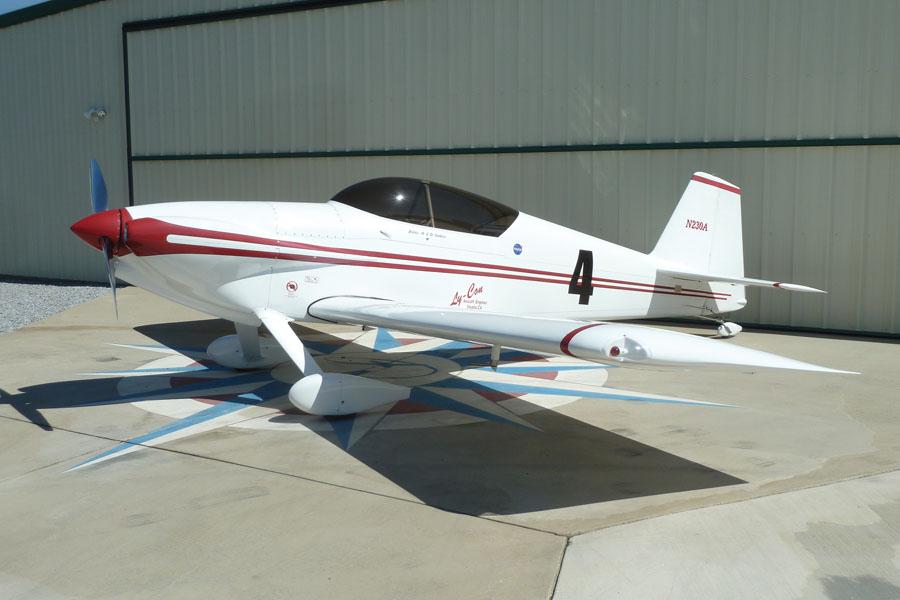
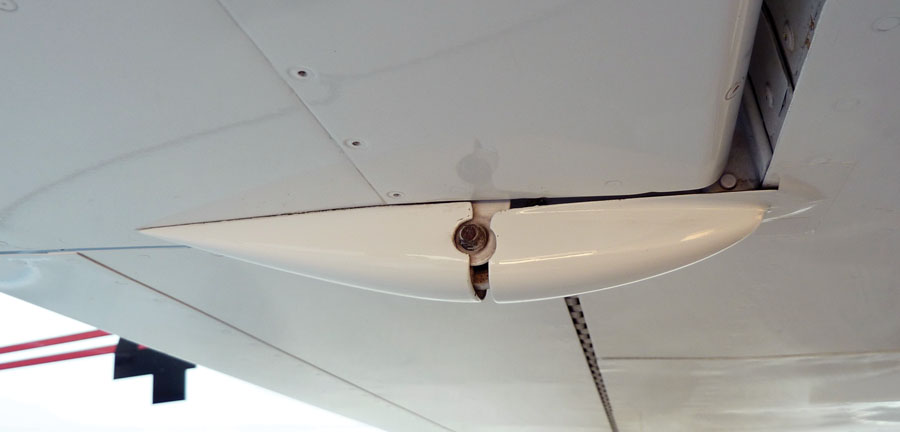
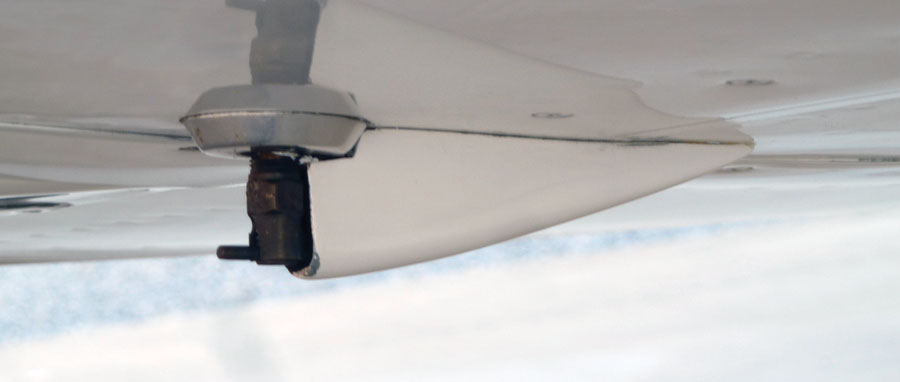
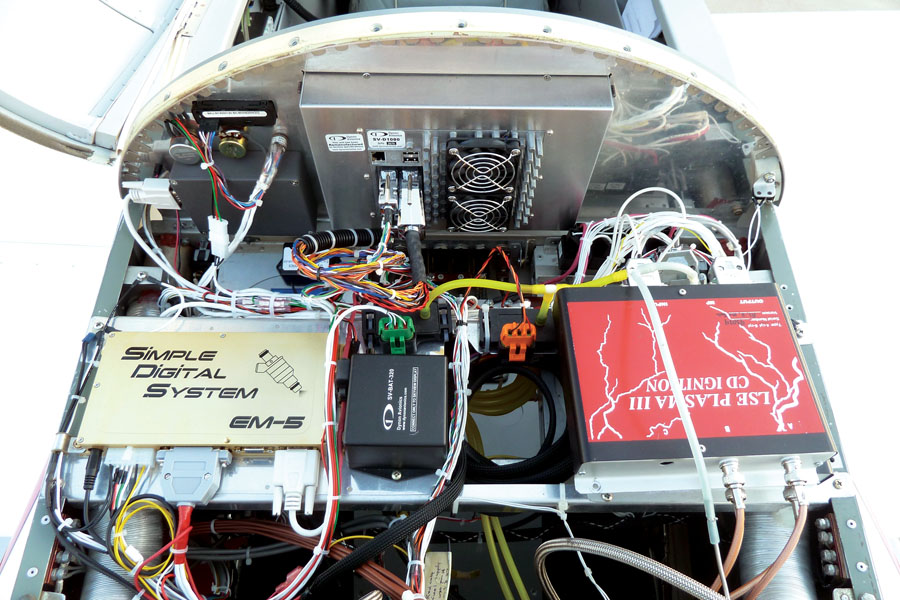

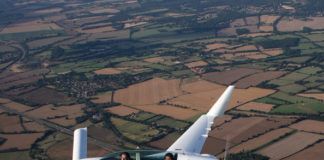
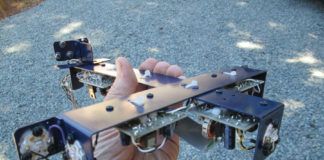
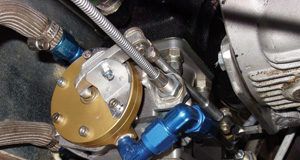
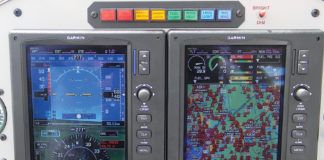
Totally thrilling! One wonders what that Pipistel would do with that electronic upgrade you have onboard!
Love it!
Great article. I have a question for Dave Anders relative to the pilot selectable timing option he explains in this article. Would it be possible to email him directly?
Thanks,
Jeff McDonald
[email protected]
303-324-1422